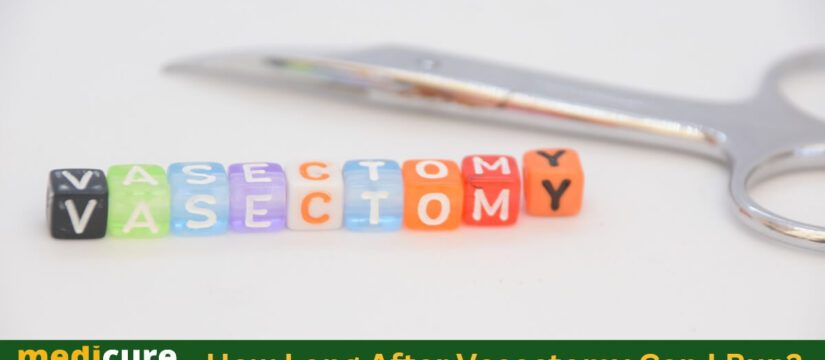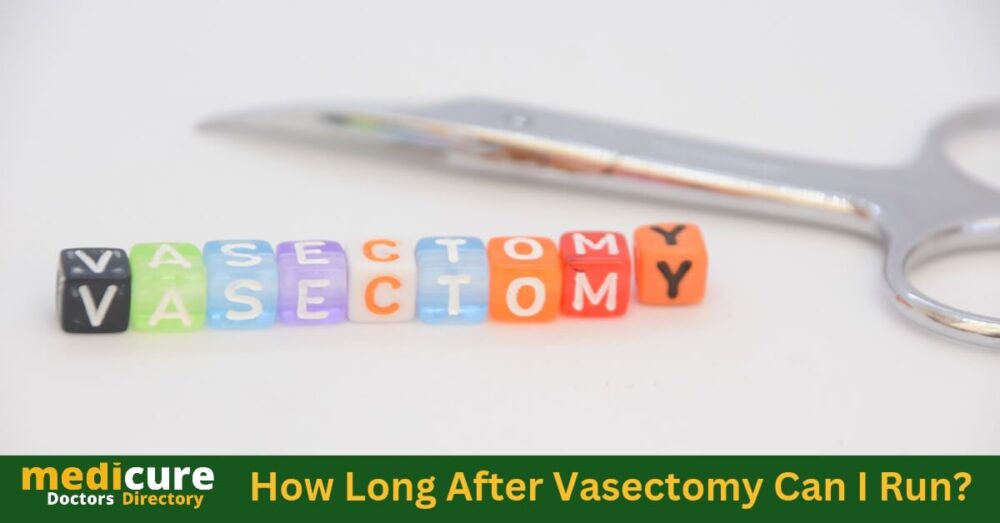MediCure
How Long After Vasectomy Can I Run ? Returning to running after a vasectomy requires patience, caution, and proper guidance. The recovery period is essential for allowing your body to heal fully and reduce the risk of complications. Consult with your doctor, follow their recommendations, and consider your individual healing progress and comfort level. By taking a gradual approach and listening to your body, you can safely reintroduce running into your routine and enjoy the benefits of regular physical activity.
How Long After Vasectomy Can I Run?
If you’re considering or have recently undergone a vasectomy, you may be wondering about the timeline for returning to your regular physical activities. Specifically, when can you safely resume running? Vasectomy is a commonly performed surgical procedure for male contraception, but it’s essential to allow sufficient time for healing and recovery before engaging in vigorous exercises.
How Long After Vasectomy Can I Run?
In this article, we will explore the post-vasectomy recovery period, the factors to consider, and provide guidance on when and how to safely reintroduce running into your routine.
Understanding Vasectomy
Before delving into the post-vasectomy running timeline, let’s briefly understand what a vasectomy entails. Vasectomy is a surgical procedure that involves cutting and sealing the vas deferens, the tubes that carry sperm from the testicles to the urethra. By interrupting the sperm’s pathway, vasectomy provides an effective form of permanent contraception.
Recovery Period After Vasectomy
The recovery period after vasectomy can be isolated into three stages: the quick post-medical procedure time frame, the underlying mending stage, and the drawn out recuperating stage. Understanding these stages is essential for checking when continuing running is proper.
1. Immediate Post-Surgery Period
After a vasectomy, it’s generally expected to encounter some distress, enlarging, and swelling in the scrotal region. Your PCP might prescribe applying ice packs to the area to lessen expanding and assuming control over-the-counter agony prescription on a case by case basis. It’s essential to rest and avoid strenuous activities during this initial phase to allow the surgical site to heal properly.
2. Initial Healing Phase
During the initial healing phase, which typically lasts about one to two weeks, the body starts to repair the incisions made during the vasectomy. While you may start feeling better during this time, it’s still crucial to avoid activities that could strain the surgical site, including running. Engaging in vigorous exercises too soon can lead to complications and delay the healing process.
3. Long-Term Healing Phase
The long-term healing phase begins after the underlying mending stage and can most recent a little while or even months. During this stage, the body keeps on mending inside, and the tissues around the careful site bit by bit fortify. It’s essential to respect this healing process and follow your doctor’s instructions regarding physical activities.
Resuming Physical Activities After Vasectomy
When it comes to resuming physical activities after a vasectomy, including running, it’s important to consider several factors.
1. Walking and Light Exercise
In the immediate post-surgery period, your doctor may encourage gentle activities such as walking to promote blood circulation and prevent blood clots. Light exercises like stretching or low-impact activities can also be beneficial. However, running falls into a higher-intensity category that should be avoided until you have sufficiently healed.
2. Running and Cardiovascular Activities
The timing for safely returning to running and other cardiovascular activities varies from person to person. It’s crucial to consult with your doctor before resuming such exercises. Your doctor will consider your individual healing progress, overall health, and any additional factors that may affect your recovery.
Factors to Consider Before Running
Before lacing up your running shoes, there are several factors you should consider.
1. Consultation with the Doctor
Always consult with your doctor before returning to running or any high-impact exercise after a vasectomy. They can assess your specific situation and provide personalized recommendations based on your healing progress and overall health.
2. Individual Healing Progress
Each person’s healing process is unique. While some individuals may recover faster and feel comfortable running within a few weeks, others may require a longer healing period. Pay attention to your body’s signals and follow your doctor’s advice regarding the optimal time to resume running.
3. Personal Comfort Level
Apart from the physical healing, it’s crucial to consider your personal comfort level before returning to running. Running is a high-impact activity that can put strain on the surgical site. If you experience any pain, discomfort, or swelling while engaging in light exercises or daily activities, it may indicate that you’re not ready to start running yet.
Gradual Return to Running
Once you’ve received clearance from your doctor and feel ready to start running again, it’s essential to take a gradual approach.
1. Starting Slowly
Begin with short, easy runs to allow your body to adjust to the increased activity level. Start with a combination of walking and jogging, gradually increasing the running duration as your body becomes more comfortable.
2. Listening to Your Body
Pay close attention to how your body responds to running. If you experience pain, discomfort, or any unusual symptoms, it’s crucial to stop and consult with your doctor. It’s better to take a step back and allow for additional healing rather than risk complications or setbacks.
3. Increasing Intensity and Duration
As your body continues to heal and adapt, you can gradually increase the intensity and duration of your runs. However, it’s important to progress at a pace that feels comfortable and doesn’t strain the surgical site.
Potential Risks and Complications
While running after a vasectomy is generally safe, there are potential risks and complications to be aware of. Excessive strain on the surgical site can lead to increased Swelling, prolonged healing, or even complications such as hematoma or infection. It’s crucial to follow the guidelines provided by your doctor and pay attention to any warning signs during your running routine.
If you experience any of the following symptoms during or after running, it’s important to seek medical attention:
- Excessive pain or discomfort in the scrotal area
- Persistent swelling or bruising
- Increased redness or warmth around the incision site
- Prolonged bleeding or discharge
- Fever or signs of infection, such as pus or foul odor
- By promptly addressing any concerns or complications, you can ensure a smoother recovery and minimize the risk of long-term issues.
Tips for a Smooth Transition Back to Running
To support your recovery and make the transition back to running as smooth as possible, consider the following tips:
1. Wearing Supportive Undergarments
Invest in supportive undergarments, such as snug-fitting briefs or athletic compression shorts. These can provide added support to the scrotal area during physical activities, reducing discomfort and minimizing the risk of strain.
2. Proper Warm-up and Stretching
Before each running session, engage in a thorough warm-up routine that includes gentle stretching exercises. This helps prepare your muscles and joints for the activity, reducing the risk of injury or strain.
3. Staying Hydrated
Keeping up with appropriate hydration is vital for by and large wellbeing and recuperation. Make a point to hydrate previously, during, and after your runs. Proper hydration supports tissue healing and helps prevent muscle cramps.
4. Paying Attention to Pain Signals
Listen to your body and pay attention to any pain signals. Discomfort or mild soreness may be expected during the recovery phase, but sharp or persistent pain could indicate a problem. If you experience unusual or worsening pain, it’s important to seek medical advice.
Also Read:
Can Ejaculating Too Soon After Vasectomy Damage It ?
How Long after Vasectomy can i Have Sex ?
How Long After a Vasectomy can i drive a car ?
FAQs How Long After Vasectomy Can I Run ?
- How soon can I start running after a vasectomy?
The timing varies from person to person. It’s important to consult with your doctor, who will consider your healing progress and provide personalized recommendations. Generally, it’s best to wait until you’ve fully healed before resuming high-impact activities like running.
- Can running after a vasectomy cause complications?
While running after a vasectomy is generally safe, it can potentially cause complications if done too soon or excessively. It’s important to follow your doctor’s guidance, start gradually, and pay attention to any warning signs or discomfort.
- What should I do if I experience pain or swelling while running after a vasectomy?
If you experience pain, swelling, or any unusual symptoms while pursuing a vasectomy, it means a lot to pause and rest. Talk with your PCP to survey what is going on and decide whether further assessment is essential.
- Are there any long-term effects of running after a vasectomy?
Pursuing a vasectomy, when done appropriately and after adequate mending, shouldn’t make any drawn out impacts. In any case, it’s critical to pay attention to your body, screen any changes, and look for clinical consideration assuming you have concerns.
- Can I engage in other forms of exercise before I start running?
Indeed, light activities like strolling, extending, or low-influence exercises can be useful during the underlying mending stage. Talk with your PCP for explicit proposals in regards to the kinds and power of activities you can participate in prior to changing back to running. Make sure to begin gradually and continuously increment the power as your body mends and turns out to be more agreeable.
How Long After Vasectomy Can I Run ?
Kindly note that while this article gives general direction, it’s fundamental to talk with your medical care supplier for customized exhortation in view of your remarkable conditions. Your primary care physician will think about variables like your general wellbeing, mending progress, and a particular contemplations connected with your vasectomy strategy.
By following the appropriate healing timeline, respecting your body’s signals, and gradually reintroducing running, you can safely resume your favorite physical activity and enjoy the benefits of an active lifestyle post-vasectomy.

